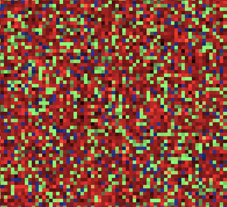
A novel technique for visualizing multispectral images is proposed. Inspired by how prisms work, our method spreads spectral information over a chromatic noise pattern. This is accomplished by populating the pattern with pixels representing each measurement band at a count proportional to its measured intensity. The method is advantageous because it allows for lightweight encoding and visualization of spectral information while maintaining the color appearance of the stimulus. A four alternative forced choice (4AFC) experiment was conducted to validate the method’s information-carrying capacity in displaying metameric stimuli of varying colors and spectral basis functions. The scores ranged from 100% to 20% (less than chance given the 4AFC task), with many conditions falling somewhere in between at statistically significant intervals. Using this data, color and texture difference metrics can be evaluated and optimized to predict the legibility of the visualization technique.

Fish quality is primarily effected by the number of days elapsed since harvesting, while bad storage conditions can also lead to quality degradation similar to the impact time. Existing approaches require laboratory testing, a laborious and timeconsuming process. In this work, we investigate technologies for quantifying fish quality though the development of deep learning models for analyzing imagery of fish. We first demonstrate that such a quantification is possible, to a certain degree, from multispectral images provided a sufficient number of training examples is available. Given that, we explore how knowledge distillation can be utilized for achieving similar fish quality estimation accuracy, but instead of using high-end multispectral imaging systems, using off-the-shelf RGB cameras. Experimental evaluation on individuals from the Mullus Marbatus family demonstrates that the proposed methodology constitutes a valid approach.

Quantification of food quality is a critical process for ensuring public health. Fish correspond to a particularly challenging case due to its high perishable nature as food. Existing approaches require laboratory testing, a laborious and timeconsuming process. In this paper, we propose a novel approach for evaluating fish freshness by exploiting the information encoded in the spectral profile acquired by a snapshot spectral camera. To extract the relevant information, we employ state-ofthe- art Convolutional Neural Networks and treat the problem as an instance of multi-class classification, where each class corresponds to a two-day period since harvesting. Experimental evaluation on individuals from the Sparidae (Boops sp.) family demonstrates that the proposed approach constitutes a valid methodology, offering both accuracy as well as effortless application.

Ancient documents were often created by overwriting older documents that had been erased to re-use the expensive parchment. There is thus the situation that we have valuable documents that actually contain possibly more valuable documents “underneath”, hidden to the human eye. Being able to retrieve these originals is an important task, however, associated with several problems. One of these is that the value of the documents limits the distribution and thus the ability to experiment. Another is that the “to be discovered” underwriting might hold important information that should first be examined, classified and put into context by textual scholars, again severely limiting the ability to experiment. This is a strong decrement to scientists and students involved in developing and testing imaging algorithms.This paper describes an approach to create artificial palimpsests that are reasonable approximations based on previous example and thus can be used by everybody to test new assumptions, new algorithms and to study the interaction of the different deterioration mechanisms.